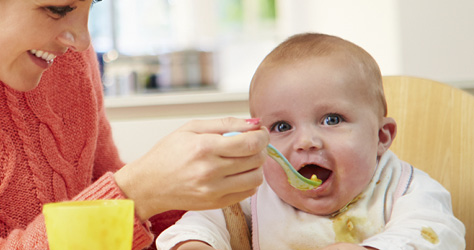Babies do cough and splutter while they are learning to eat, but do you know what to do if they start choking?
Here’s a quick guide to spotting choking and the best way to help them safely and quickly.
At a glance
- Babies won't be able to cry, cough, make any other noise or breathe if they are choking so make sure you are always watching them.

Keep watching
Because babies are so new to food, things can go down the wrong way more easily than usual. So it’s really important you stay with them all the time they’re eating – just in case.
Gagging, Coughing, spluttering and choking
Babies do gag, cough and splutter sometimes while they are learning to eat - it’s a normal part of learning how to cope with all that lovely solid food. Babies cough back (or gag) a lump or piece of food that is too big for them to swallow. They can then chew it a bit more before trying again.
Choking is when the food becomes stuck and they cannot cough or gag it back. Unlike gagging, if they are choking they will look scared, be struggling to breathe and make no sound.
If they seem to be struggling, they may have food stuck and need some gentle help. You can pop your finger in their mouth to clear some of the food – but if they’re choking, be careful not to push it further down.
Some babies may simply shove too much food in their mouths and then find they can’t swallow it. Again, put your finger in their mouth and scoop out some of the extra food.
Choking
If your baby is choking, they won’t be able to cry, cough, make any other noise or breathe. To make sure you know what to do if this happens try these steps advised by the NHS.
- If you can see the item that is stuck, try to get it out but don’t poke around repeatedly with your fingers if you are not able to see it. You could make things worse by pushing the object further in and making it harder to get out.
- If your little one is coughing loudly, there’s no need to do anything. Encourage them to carry on coughing and stay with them.
- If your baby’s coughing is not helping (it’s silent or they can’t breathe in properly), shout for help immediately and assess whether they’re still conscious.
- If your baby is still conscious, but they’re either not coughing or their coughing is not effective, try back blows.
Back blows for babies under one year
- Sit down and lay your baby face down on your thighs, supporting their head with your hand.
- Give up to five sharp back blows with the heel of one hand in the middle of the back between the shoulder blades.
Chest thrusts for children under one year
- Lay your baby face up along the length of your thighs.
- Find the breastbone, and place two fingers in the middle.
- Give five sharp chest thrusts (pushes), compressing the chest by about a third.
Following these attempts, reassess your baby as follows:
- If the object is still not dislodged and your little one is still conscious, continue the sequence of back blows and either chest thrusts.
- Call out or send for help, if you're still on your own.
- Don't leave your baby.
- Even if the object has come out, get medical help. Part of the object might have been left behind, or your little one might have been hurt by the procedure.
If your baby falls unconcious while choking
- If a choking baby is, or becomes, unconscious, put them on a firm, flat surface and shout for help.
- Call 999, putting the phone on speakerphone so your hands are free.
- Don't leave your baby at any stage.
- Open your baby's mouth. If the object is clearly visible and you can grasp it easily, then remove it.
- Start CPR
Get further advice on CPR from the NHS website.